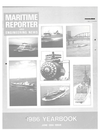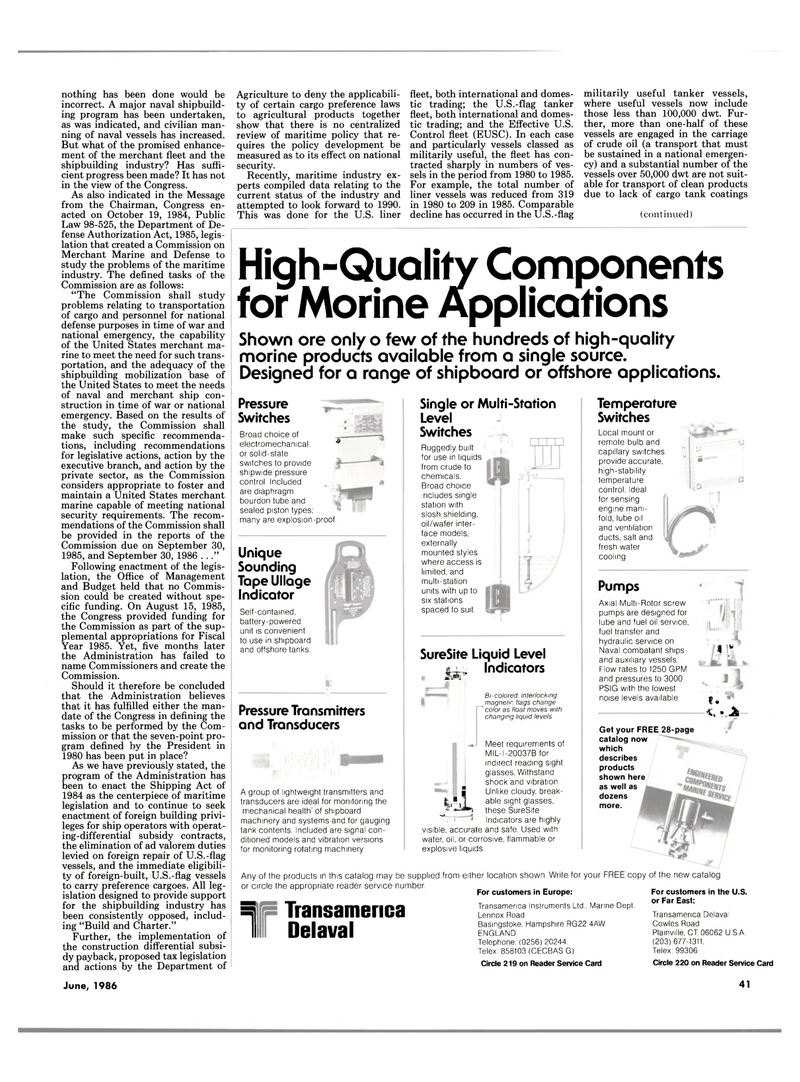
Page 41: of Maritime Reporter Magazine (June 1986)
Read this page in Pdf, Flash or Html5 edition of June 1986 Maritime Reporter Magazine
nothing has been done would be incorrect. A major naval shipbuild- ing program has been undertaken, as was indicated, and civilian man- ning of naval vessels has increased.
But what of the promised enhance- ment of the merchant fleet and the shipbuilding industry? Has suffi- cient progress been made? It has not in the view of the Congress.
As also indicated in the Message from the Chairman, Congress en- acted on October 19, 1984, Public
Law 98-525, the Department of De- fense Authorization Act, 1985, legis- lation that created a Commission on
Merchant Marine and Defense to study the problems of the maritime industry. The defined tasks of the
Commission are as follows: "The Commission shall study problems relating to transportation of cargo and personnel for national defense purposes in time of war and national emergency, the capability of the United States merchant ma- rine to meet the need for such trans- portation, and the adequacy of the shipbuilding mobilization base of the United States to meet the needs of naval and merchant ship con- struction in time of war or national emergency. Based on the results of the study, the Commission shall make such specific recommenda- tions, including recommendations for legislative actions, action by the executive branch, and action by the private sector, as the Commission considers appropriate to foster and maintain a United States merchant marine capable of meeting national security requirements. The recom- mendations of the Commission shall be provided in the reports of the
Commission due on September 30, 1985, and September 30, 1986 ..."
Following enactment of the legis- lation, the Office of Management and Budget held that no Commis- sion could be created without spe- cific funding. On August 15, 1985, the Congress provided funding for the Commission as part of the sup- plemental appropriations for Fiscal
Year 1985. Yet, five months later the Administration has failed to name Commissioners and create the
Commission.
Should it therefore be concluded that the Administration believes that it has fulfilled either the man- date of the Congress in defining the tasks to be performed by the Com- mission or that the seven-point pro- gram defined by the President in 1980 has been put in place?
As we have previously stated, the program of the Administration has been to enact the Shipping Act of 1984 as the centerpiece of maritime legislation and to continue to seek enactment of foreign building privi- leges for ship operators with operat- ing-differential subsidy contracts, the elimination of ad valorem duties levied on foreign repair of U.S.-flag vessels, and the immediate eligibili- ty of foreign-built, U.S.-flag vessels to carry preference cargoes. All leg- islation designed to provide support for the shipbuilding industry has been consistently opposed, includ- ing "Build and Charter."
Further, the implementation of the construction differential subsi- dy payback, proposed tax legislation and actions by the Department of
Agriculture to deny the applicabili- ty of certain cargo preference laws to agricultural products together show that there is no centralized review of maritime policy that re- quires the policy development be measured as to its effect on national security.
Recently, maritime industry ex- perts compiled data relating to the current status of the industry and attempted to look forward to 1990.
This was done for the U.S. liner fleet, both international and domes- tic trading; the U.S.-flag tanker fleet, both international and domes- tic trading; and the Effective U.S.
Control fleet (EUSC). In each case and particularly vessels classed as militarily useful, the fleet has con- tracted sharply in numbers of ves- sels in the period from 1980 to 1985.
For example, the total number of finer vessels was reduced from 319 in 1980 to 209 in 1985. Comparable decline has occurred in the U.S.-flag militarily useful tanker vessels, where useful vessels now include those less than 100,000 dwt. Fur- ther, more than one-half of these vessels are engaged in the carriage of crude oil (a transport that must be sustained in a national emergen- cy) and a substantial number of the vessels over 50,000 dwt are not suit- able for transport of clean products due to lack of cargo tank coatings (continued)
High-Quality Components for Morine Applications
Shown ore only o few of the hundreds of high-quality morine products available from a single source.
Designed for a range of shipboard or offshore applications.
Pressure
Switches
Broad choice of electromechanical or solid-state switches to provide shipwide pressure control. Included are diaphragm bourdon tube and sealed piston types; many are explosion-proof s
Unique
Sounding
Tape Ullage
Indicator
Self-contained, battery-powered unit is convenient to use In shipboard and offshore tanks.
Pressure Transmitters and Transducers
A group of lightweight transmitters and transducers are ideal for monitoring the mechanical health' of shipboard machinery and systems and for gauging tank contents. Included are signal con- ditioned models and vibration versions for monitoring rotating machinery
Single or Multi-Station
Level
Switches
Ruggedly built for use in liguids from crude to chemicals.
Broad choice ncludes single station with slosh shielding, oil/wafer inter- face models, externally mounted styles where access is limited, and multi-station units with up to six stations spaced to suit.
SureSite Liquid Level
Indicators fe *
Bi-colored, interlocking magnetic flags change ' color as float moves with changing liquid levels
Meet reguirements of
MIL-I-20037B for indirect reading sight glasses. Withstand shock and vibration
Unlike cloudy, break- able sight glasses, these SureSite -j Indicators are highly visible, accurate and safe. Used with water, oil, or corrosive, flammable or explosive liquids. t a h'X
Temperature
Switches
Local mount or remote bulb and capillary switches provide accurate, high-stability temperature control Ideal for sensing engine mani- fold, lube oil and ventilation ducts, salt and fresh water cooling
Pumps
Axial Multi-Rotor screw pumps are designed for lube and fuel oil service, fuel transfer and hydraulic service on
Naval combatant ships and auxiliary vessels.
Flow rates to 1250 GPM and pressures to 3000
PSlG with the lowest noise levels available
Get your FREE 28-page
catalog now
which
describes
products
shown here
as well as
dozens
more.
4 v
f •
" Any of the products in this catalog may be supplied from either location shown. Write for your FREE copy of the new catalog
or circle the appropriate reader service number.
1 Transamerica Delaval
For customers in Europe:
Transamerica Instruments Ltd . Marine Dept.
Lennox Road
Basingstoke. Hampshire RG22 4AW
ENGLAND
Telephone: (0256) 20244.
Telex 858103 (CECBAS G)
Circle 219 on Reader Service Card
For customers in the U.S.
or Far East:
Transamerica Delava
Cowles Road
PlainviIle, CT 06062 U.S.A.
(203) 677-1311,
Telex: 99306
Circle 220 on Reader Service Card
June, 1986 41

 40
40

 42
42
